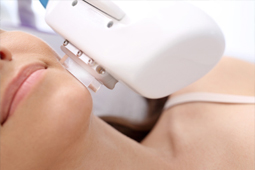Whether your scar is from surgery or an accident, the healing process can be unpredictable. It can take a year, sometimes longer, for a scar to fully heal. A number of factors can affect the severity of scarring, including the size and depth of the wound, the blood supply to the area, the thickness and color of your skin, and the direction of the scar. If you are bothered by the appearance of a scar after it has fully healed, or if it restricts the motion of a joint or limb, you may want to explore the option of scar revision.
Scar revision does not completely remove a scar, but it can often improve the appearance of a scar and make it less obvious. This is done through injection or application of certain steroid medications, dermabrasion, or through scar revision surgery.
Scar revision surgery
- Plastic surgeons may perform this procedure when a scar crosses areas of the skin that are highly visible or involve frequent movement. After scar revision, the scar is less noticeable and the skin can flex and move more easily. Scar revision procedures may include the following, depending on the type and severity of the scar:
- Z-plasty is used to reposition the scar so that it more closely conforms to the natural lines and creases of the skin. This technique is commonly used to improve function and increase mobility of joints or limbs.
- Skin Grafting involves the transfer of healthy skin from another part of the body to cover the injured area.
- Tissue Expansion is when expanders are placed under the skin and slowly filled with water to stretch the skin. Similar to water balloons, these expanders create new tissue that can be used to cover existing scars.
- Flap Surgery is a complex procedure for moving skin (and also the underlying fat, blood vessels, and muscle) from a healthy part of the body to the injured site.
Keloid removal

A keloid is an abnormal growth of scar tissue that forms at the site of a wound, often near a surgical incision or injury. Unlike normal scars, keloid scars extend well beyond the normal margins of the wound and are more likely to appear in areas where the skin is subjected to high tension. Many treatments are available to repair or remove keloid scars, including dressings, medication, and surgical removal and treatments are often combined for best results. For more severe keloid scars, laser surgery, cryotherapy, and radiation are also available.
Planning and recovery
What to expect
If you are bothered by a scar, our surgeons will evaluate your scar and discuss potential treatment options. Your surgeon will also discuss the risks associated with treatment and possible outcomes. During your consultation, you will have the opportunity to ask any questions you may have about your surgery.
Recovery after scar revision
It’s important to follow your surgeon’s instructions after scar revision surgery to make sure the wound heals properly. Your surgeon will advise you on gradually returning to your normal activities following surgery.
Your scar might look worse when you first see it after surgery don’t worry, this is normal. As you heal, keep in mind that the final results of your surgery may not be apparent for a year or more. The degree of improvement depends on the size of your scar, the nature and quality of your skin, and how well you care for the wound after the operation.
Our providers
Location: Change location Enter your location
Plastic Surgery
-
Christopher Ernst Attinger, MD
Plastic and Reconstructive Surgery & Plastic Surgery
-
Stephen Bradley Baker, MD
Facial Plastic Surgery, Plastic Surgery & Craniofacial Plastic Surgery
-
Akash Chadha, DMSc MMS PA
Wound Care & Plastic Surgery
-
Gabriel Alfonso Del Corral, MD
Plastic Surgery, Microsurgery, Family Medicine, Microvascular Plastic Surgery, Gender Surgery & Reconstructive Plastic Surgery
-
Kenneth L Fan, MD
Plastic Surgery
-
James P. Higgins, MD
Reconstructive Plastic Surgery, Plastic Surgery & Hand Surgery
-
Samer Jabbour, MD
Microvascular Plastic Surgery, Plastic Surgery, Breast Surgery & Reconstructive Plastic Surgery
-
Pornchanok Kheocha-on, FNPBC MPH MSN
Plastic Surgery & Family Medicine
-
Grant Michael Kleiber, MD
Hand Surgery & Plastic Surgery
-
Margaret Curran Kugler, ACNP-BC NP
Plastic Surgery & Wound Care
-
David Zachary Martin, MD
Plastic Surgery
-
Kimberly Ann Miller, FNPBC MSN
Plastic Surgery
-
Kathryn M Sidrow, MMPAS PA
Emergency Medicine & Plastic Surgery
-
Ailyn Grace Bernabe Sims, MSN NP
Plastic Surgery & Reconstructive Plastic Surgery
-
David Habin Song, MD
Plastic Surgery & Reconstructive Plastic Surgery
-
Konrad Laird Dawson, MD
Plastic Surgery
Our locations
Distance from Change locationEnter your location
MedStar Georgetown University Hospital
3800 Reservoir Rd. NW Washington, DC, 20007
MedStar Washington Hospital Center
110 Irving St. NW Washington, DC 20010
Frequency asked questions
-
How long should I wait before considering scar revision?
There’s no need to rush into scar revision surgery it’s important to wait until the scar is fully healed. Your scar may become smaller and less noticeable with time, or it may be treated with steroids to relieve symptoms, such as tenderness and itching. We recommend waiting a year or more after an injury or surgery before you decide to have scar revision.
-
Is scar revision covered by insurance?
Insurance usually does not cover cosmetic procedures. If scar revision is needed to improve your ability to function, it could be partially covered. Check your policy or call your carrier to confirm your coverage.
-
What are the risks of scar revision?
Scar revision is known to be a safe procedure; however, as with any procedure, there are potential risks. Complications may include infection, bleeding, having a reaction to anesthesia, or the recurrence of a scar. By following your doctor’s advice before and after surgery, you can reduce your risk for complications.









